Energy is eternal delight. - Blake
Energy is the ability to do work. - Textbook
Science stories incorporate a "scientific element" and a "humanistic element". We have found that even the simple telling of such stories as "Archimedes' Adventures", "A Day in the Life of an Alchemist", and "Torricelli and the weight of the atmosphere", the crafting of the story is a humanistically creative process. The power of "stories" comes from the simple attribute of "making sense" and providing a coherent vision. In fact, most people will impose coherence on a set of random sentences in an attempt to create a context for what they are reading or hearing (Kenealy, 1989).
By 2003 I had written two science plays: "The Age-of-the-Earth Debate" and "Count Rumford". The first was performed at the 5th IHPST conference in Como Italy in October 1999, at the Deutsches Museum, Munich, in November 2000, and at the University of Manitoba in Winnipeg in August of 2001. The second play, "Count Rumford" was performed at the Deutsches Museum in December of 2002. A revised version of "Count Rumford" was performed at the IHPST conference in the Eckart-Gramate hall of the University of Winnipeg in 2003. It was also shown on Bavarian Television on two occasions. The first play was published in Science & Education.
What may be unique in the dramatization of the Age of the Earth debate is that the 'personae dramatis' were all professors or practising scientists in geology, physics, and biology. These experts first acquainted themselves with the original script and then researched the history of science in the period appropriate for the time of the debate. This double preparation allowed them to present the ideas not only with authority and authenticity but allowed them to go beyond the text and respond spontaneously to the 'demands of the moment'. Going beyond the text produced spontaneous responses that were unexpected, often humorous, sometimes emotional, clearly showing the human side of science. Indeed, the numerous digressions to the black board in order to illustrate ideas relieved the presentation from being a static conversation around a table. Finally, the moderator was also a professor representing the 'intelligent lay person', thus making the drama appear as a contemporary 'talk show'.
Recent Work
- A play entitled "Alexander and Aristotle" was performed at Assos in Turkey (where Aristotle lived for a while and met the young Alexander).
- A play about Einstein, in connection with the Annus Mirabilis celebration of 2005, in collaboration with Juergen Teichmann, Director of Programs at the Deutsches Museum in Munich. This play was performed (in German) at the Deutsches Museum in Munich, October 26 and again on October 3, 2005. The title of the play is: "Einstein contra Newton". The play is available on a DVD from the Deutsches Museum in Munich.
Science Plays Written and Performed
"The-Age-of-the-Earth debate. Performed at:
- IHPST (International Conference of the History and Philosophy of Science), at Lake Como in October, 1999
- Deutsches Museum in Munich in November of 1999, in German.
- University of Munich, in January of 2000, in German.
- Shown on Bavarian TV in January, 2000.
- University of Manitoba , as a public performance, May of 2001.
"Count Rumford". Performed in German at:
- Deutsches Museum in Munich, December, 2003.
- IHPST conference at the University of Winnipeg, July, 2003.
"An Evening with Albert Einstein and Sir Isaac Newton". Performed in German at:
- Deutsches Museum, on December 16 and 17.
- IHPST conference in July 2007, University of Calgary.
"Galileo meets Kepler: Motion on Earth and in the Heavens". Performed:
- The Science Center, Windsor, Ontario. April 23. 2009.
- IHPST conference at the University of Notre Dame, Indiana, June, 2009.
- XXIII Congress of History of Science and Technology, Budapest, Hungary, August, 2009.
- Additional performances planned:
- Annual Meeting of the Royal Canadian Astronomical Society, in the Fall of 2009.
- Deutsches Museum, Munich, on December 16 and 17. deutsches-museum.de
Publications
Stinner, A. (2012). Alexander and Aristotle.
![]() View as PDF
View as PDF
Stinner, A. (2008). Galileo meets Kepler: Motion in the Heavens.
![]() View as PDF
View as PDF
Stinner, A. (2007). Toward a Humanistic Science Education: Using Stories, Drama, and the Theater, Canadian Theater Review, pp. 14-19. (This was an invited article for a special edition of the journal).
![]() View as PDF
View as PDF
Stinner, A. (2007). An Evening with Albert Einstein and Isaac Newton.
![]() View as PDF
View as PDF
Stinner, A. (2007). Albert Einstein: Creator and Rebel.
![]() View as PDF
View as PDF
Stinner, A. (2007). Conversations with great physicists about motion.
![]() View as PDF
View as PDF
Stinner, A. (2007). Archimedes and Aristarchus on Samos.
![]() View as PDF
View as PDF
Stinner, A. (2007). Alessandro Volta and Luigi Galvani.
![]() View as PDF
View as PDF
Stinner, A. (2007). Copernicus and the Aristotelians: A Debate
![]() View as PDF
View as PDF
Stinner, A. & Teichmann, J. (2003). Lord Kelvin and the The-Age-of-the-Earth debate: A dramatization. Science & Education.
![]() View as PDF
View as PDF
Stinner, A. (2003). Count Rumford: A Science Dramatization.
![]() View as PDF
View as PDF




